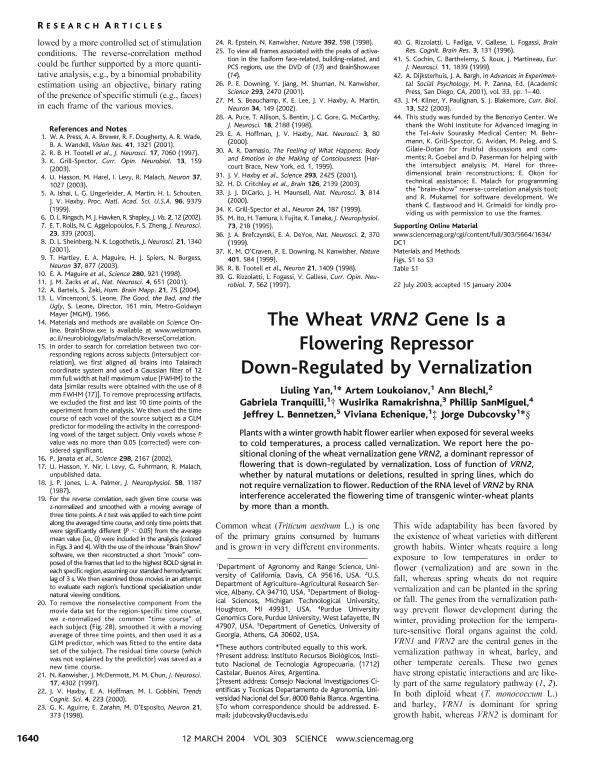Mostrar el registro sencillo del ítem
dc.contributor.author
Yan, Liuling
dc.contributor.author
Loukoianov, Artem
dc.contributor.author
Blechl, Ann
dc.contributor.author
Tranquilli, Gabriela Edith

dc.contributor.author
Ramakrishna, Wusirika
dc.contributor.author
San Miguel, Phillip
dc.contributor.author
Bennetzen, Jeffrey L.
dc.contributor.author
Echenique, Carmen Viviana

dc.contributor.author
Dubcovsky, Jorge

dc.date.available
2017-12-12T16:38:41Z
dc.date.issued
2004-03
dc.identifier.citation
Yan, Liuling; Loukoianov, Artem; Blechl, Ann; Tranquilli, Gabriela Edith; Ramakrishna, Wusirika; et al.; The wheat VRN2 gene is a flowering repressor down-regulated by vernalization; American Association for the Advancement of Science; Science; 303; 5664; 3-2004; 1640-1644
dc.identifier.issn
0036-8075
dc.identifier.uri
http://hdl.handle.net/11336/30272
dc.description.abstract
Plants with a winter growth habit flower earlier when exposed for several weeks to cold temperatures, a process called vernalization. We report here the positional cloning of the wheat vernalization gene VRN2, a dominant repressor of flowering that is down-regulated by vernalization. Loss of function of VRN2, whether by natural mutations or deletions, resulted in spring lines, which do not require vernalization to flower. Reduction of the RNA level of VRN2 by RNA interference accelerated the flowering time of transgenic winter-wheat plants by more than a month.
dc.format
application/pdf
dc.language.iso
eng
dc.publisher
American Association for the Advancement of Science

dc.rights
info:eu-repo/semantics/openAccess
dc.rights.uri
https://creativecommons.org/licenses/by-nc-sa/2.5/ar/
dc.subject
Cloning
dc.subject
Wheat
dc.subject
Vernalization
dc.subject
Transgenic
dc.subject.classification
Otras Ciencias Biológicas

dc.subject.classification
Ciencias Biológicas

dc.subject.classification
CIENCIAS NATURALES Y EXACTAS

dc.title
The wheat VRN2 gene is a flowering repressor down-regulated by vernalization
dc.type
info:eu-repo/semantics/article
dc.type
info:ar-repo/semantics/artículo
dc.type
info:eu-repo/semantics/publishedVersion
dc.date.updated
2017-11-16T14:58:27Z
dc.journal.volume
303
dc.journal.number
5664
dc.journal.pagination
1640-1644
dc.journal.pais
Estados Unidos

dc.journal.ciudad
Washington
dc.description.fil
Fil: Yan, Liuling. University of California; Estados Unidos
dc.description.fil
Fil: Loukoianov, Artem. University of California; Estados Unidos
dc.description.fil
Fil: Blechl, Ann. United States Department of Agriculture; Estados Unidos
dc.description.fil
Fil: Tranquilli, Gabriela Edith. University of California; Estados Unidos
dc.description.fil
Fil: Ramakrishna, Wusirika. Michigan Technological University; Estados Unidos
dc.description.fil
Fil: San Miguel, Phillip. Purdue University; Estados Unidos
dc.description.fil
Fil: Bennetzen, Jeffrey L.. University of Georgia; Estados Unidos
dc.description.fil
Fil: Echenique, Carmen Viviana. Consejo Nacional de Investigaciones Científicas y Técnicas. Centro Científico Tecnológico Conicet - Bahía Blanca. Centro de Recursos Naturales Renovables de la Zona Semiárida. Universidad Nacional del Sur. Centro de Recursos Naturales Renovables de la Zona Semiárida; Argentina
dc.description.fil
Fil: Dubcovsky, Jorge. University of California; Estados Unidos
dc.journal.title
Science

dc.relation.alternativeid
info:eu-repo/semantics/altIdentifier/url/http://science.sciencemag.org/content/303/5664/1640
dc.relation.alternativeid
info:eu-repo/semantics/altIdentifier/doi/http://dx.doi.org/10.1126/science.1094305
Archivos asociados
